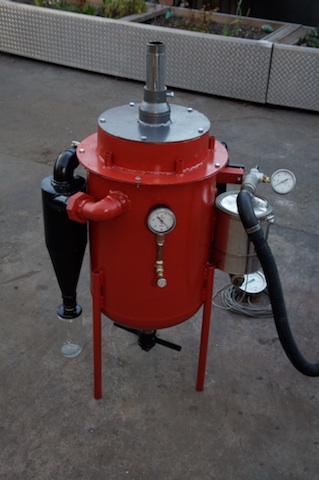Gasifier Experimenters Kit (GEK)
Jim Mason, March 4, 2008
Gasifier Experimenters Kit
Today we added some run pictures http://theshipyard.org/gek/ showing the "gasifier experimenters kit" in operation. most of these are on the second page of the collection. you can see the addition of perlite into the "tube in tube" infill insulation (i didn't have ash, as intended) and the pellet fuel loaded.
Note in the run pictures the new (very simple) cyclonic burner. see here:
http://theshipyard.org/gek/large-35.html. this burns in a much more stable manner than any linear burner I've made to date. good mixing and no problem with the gas rate outrunning the flamefront speed (as it is going in a circle). All it is is a 5" diameter tube of 12" length, with a 1.5" black pipe "venturi cowling" welded for a tangential entry. a 1/2" black pipe nozzle with the gas is positioned blowing through this opening to get the venturi going.
we also used this run to start testing bear's diy and open source gas sensing rig. see here: http://theshipyard.org/gek/large-37.html. nothing is calibrated yet, but bear did get meaningful feed back from all sensors:
CO, H2, CO2, O2, and mixed HC (trying for methane). bear's board also takes
4 thermal couple type K inputs, and two pressure/vac inputs. all data is displayed in real time and exported to an excel file and graphing program for later mining. there are lots of issues still to work out here, but at some point we will offer plans to make this as well as assembled units to those who are interested.
-------
Here's a link to some initial pictures of the "gasifier experimenter's kit" (aka: The GEK Gasifier) i mentioned in the post below.
http://theshipyard.org/gek/
Later will come run pictures, as well as a more detailed description of the architectural types and specific parameters that can be varied.
I agree we need better comparison data and operating experience between these types. so much is anecdotal, and largely related to each of our personal favorite horses in this race. even much of the "quantitative" data happens between units of such different dimension, scale, architectural particulars and insulative realities that the "quantitative" data becomes rather "qualitative" when compared to data from other sites.
To help with this problem, one of the things we've been working on of late is an "experimenters gasifier kit" that allows for the easy and modular change out between these different modes in the same unit, so that direct comparison and rich learning is possible. the goal has been to make a full gasifier lego system- a unit where all the major and many of the minor downdraft architectural types are available in a single unit, and easily changed between for good comparison and formal research.
We now have a unit that can easily re-bolt the main insert so as to move between core and Imbert types. different open core tube sizes are installable via a simple bolt down bottom ring. in the Imbert type, restriction sizes and different varieties of reduction cone designs similarly bolt in. related air delivery points are movable up and down, as well as in and out. nozzles sizes in cast iron or stainless change out as desired.
Hybrids are also possible between the two main types, with air dedicated air delivery to pyrolysis and combustion zone, but still with open top, (a la mukunda, et al). similarly, the top hopper can change out from "none" for small batch lab work, to traditional insulated bin, and non-insulated monorator design.
I will post some pictures and more detailed explanations of the "lego gasifier" soon. today i am shipping it off to the Canadian professor who ordered it for a biomass energy program.
I will be open sourcing this design with full doc soon, in the hopes that it will prove useful for others. hopefully others will develop new "bolt in" components that expand the available library of comparative options for the unit.
I have yet to write up the details other than the quick summary in the old note below.
As you will see in the pictures, the fabrication has been reduced to tubes, plates and standard plumbing parts. the tubes all correspond to common North American tank types (of 14" 12" and10"). the plates are circular cut with a plasma cutter by hand with a protractor. the plumbing is NPT black pipe and cast iron sewer connectors for the reduction zone bells. the insulation is ash in a "tube in tube" in fill arrangement. the dimensional range is derived from a full review the historic Imbert and Swedish literature, as well as relevant contemporary downdraft literature. combustion and reduction architectures cover historic designs currently, but most contemporary variants can be easily fabricated and "inserted" at different bolt points in the unit. the unit in the picture shows a basic MEN type air preheating arrangement. Bungs, TC inserts and other access is provided for measurement of temp and vacuum at all relevant points across the system.
The goal with this unit is a fully flexible and architecturally diverse gasifier that can be built from easy commodity parts, but with a full and motivated range of configuration and data measurement potentials. DIY folks can build on their own from local "obtainium", or "full parts assemble yourself" kits are easily manufactured from rolled tubes and CNC plasma cut plates. we will soon be offering kits and complete units for sale, largely aimed at educators, researchers, and DIY enthusiasts.
More next week when i get the drawings and writing together.
3
